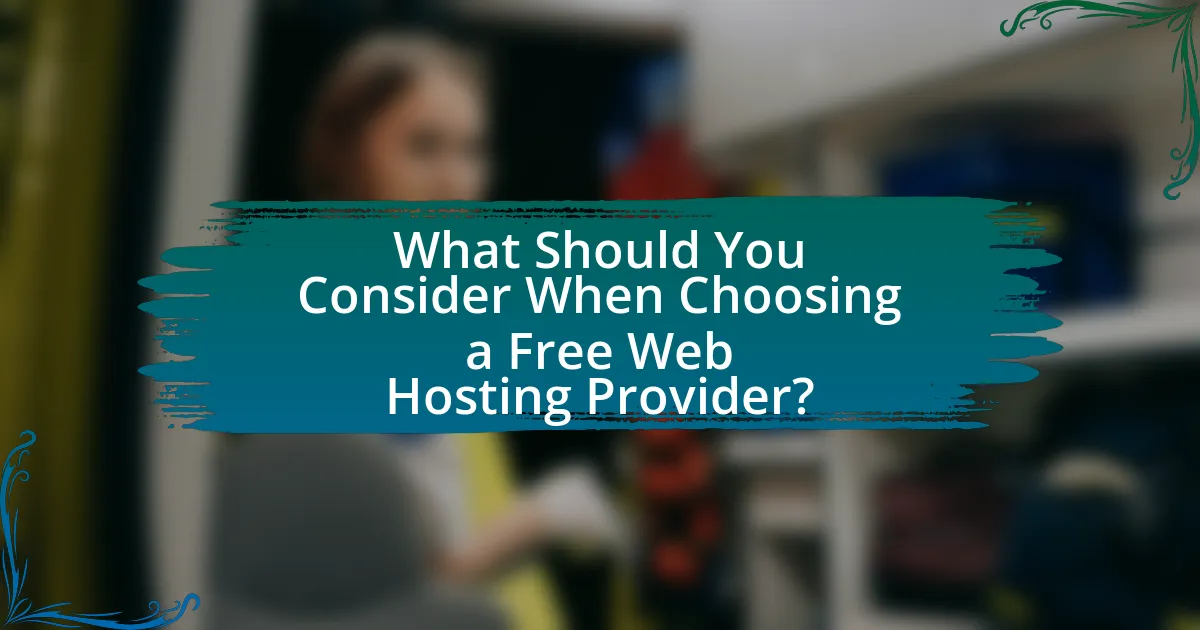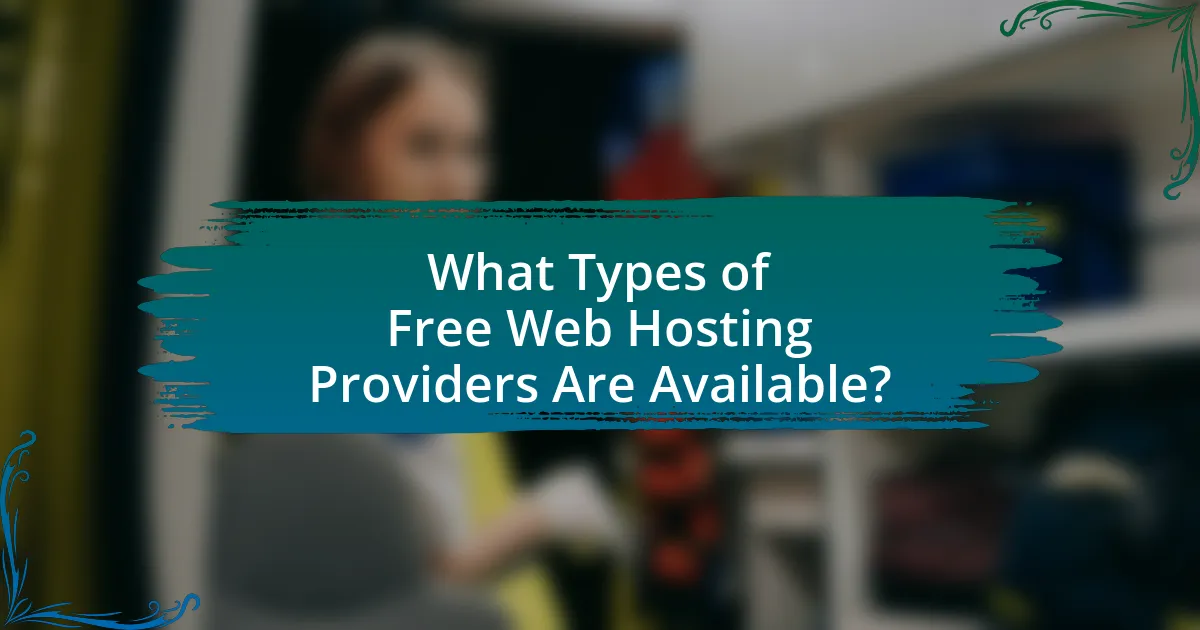Choosing the right free web hosting provider is crucial for ensuring your website’s performance, reliability, and security. Key considerations include the provider’s uptime guarantees, storage and bandwidth limits, security features, and customer support availability. The article explores how specific website needs, expected traffic, and the types of sites being hosted influence the choice of a provider. It also discusses the potential drawbacks of free hosting services, such as limited resources and the impact of advertisements on user experience. Additionally, it outlines best practices for optimizing website performance and security while using free hosting options.

What Should You Consider When Choosing a Free Web Hosting Provider?
When choosing a free web hosting provider, consider the provider’s reliability and uptime guarantees. Reliable providers typically offer at least 99.9% uptime, ensuring your website remains accessible. Additionally, evaluate the storage and bandwidth limits, as many free hosts impose strict restrictions that can hinder your site’s performance. Security features, such as SSL certificates and regular backups, are also crucial, as they protect your data and enhance user trust. Furthermore, assess the level of customer support available; responsive support can be vital for resolving issues quickly. Lastly, review any hidden costs or limitations that may arise, as some free services may include ads or restrict functionality, impacting your website’s effectiveness.
How do your specific needs influence your choice of a web hosting provider?
Your specific needs directly influence your choice of a web hosting provider by determining the features and services that are essential for your website’s performance and functionality. For instance, if you require high traffic capacity, you would prioritize providers that offer scalable bandwidth and robust server resources. Additionally, if your website relies on specific technologies, such as WordPress or e-commerce platforms, you would select a provider that specializes in those areas, ensuring compatibility and optimal performance. Furthermore, security needs, such as SSL certificates and regular backups, would guide you toward providers that emphasize these features. According to a survey by HostingAdvice, 70% of users reported that specific needs like uptime reliability and customer support were critical factors in their hosting provider selection.
What types of websites are you planning to host?
I am planning to host personal blogs, e-commerce sites, and portfolio websites. Personal blogs typically require minimal resources and can benefit from user-friendly platforms, while e-commerce sites demand robust security and scalability to handle transactions. Portfolio websites focus on showcasing work and often require high-quality image hosting and customization options. These types of websites align with the varying needs of users seeking free web hosting solutions, which often cater to different functionalities and resource requirements.
How much traffic do you expect to receive?
The expected traffic for a website using a free web hosting provider typically ranges from 1,000 to 10,000 visitors per month, depending on factors such as niche, marketing efforts, and content quality. This estimate is based on industry observations where many free hosting services limit bandwidth and resources, which can restrict traffic growth. For instance, platforms like WordPress.com and Wix often have user traffic caps that can affect the overall visitor count.
What are the key features to look for in a free web hosting provider?
Key features to look for in a free web hosting provider include storage space, bandwidth, uptime reliability, customer support, and ease of use. Storage space determines how much data you can host, while bandwidth affects the amount of traffic your site can handle. Uptime reliability is crucial, as a provider should guarantee at least 99.9% uptime to ensure your website is accessible. Customer support is important for resolving issues quickly, and ease of use, including a user-friendly interface and one-click installations, enhances the overall experience. These features collectively ensure that the hosting service meets your website’s operational needs effectively.
What storage and bandwidth limits should you be aware of?
Free web hosting providers typically impose storage limits ranging from 1 GB to 10 GB and bandwidth limits between 5 GB to 100 GB per month. These limits can significantly affect website performance and accessibility. For instance, a provider with a 5 GB bandwidth cap may restrict your site’s visibility if traffic exceeds this threshold, leading to downtime or throttled speeds. Additionally, storage limits can restrict the amount of content you can host, impacting your site’s growth and functionality. Understanding these limits is crucial for selecting a provider that aligns with your website’s needs and expected traffic.
How important is customer support for your hosting needs?
Customer support is crucial for hosting needs, as it directly impacts the reliability and performance of a website. Effective customer support ensures that any technical issues are resolved promptly, minimizing downtime and maintaining user satisfaction. According to a survey by Zendesk, 82% of customers have stopped doing business with a company due to poor customer service, highlighting the importance of responsive support in the hosting industry. Additionally, hosting providers with robust customer support often receive higher ratings and customer loyalty, which can be critical for businesses relying on their online presence.
What are the potential drawbacks of using free web hosting services?
The potential drawbacks of using free web hosting services include limited storage and bandwidth, lack of customer support, and the presence of advertisements on hosted sites. Free web hosting often restricts the amount of data and traffic a website can handle, which can hinder performance and scalability. Additionally, many free services do not offer reliable customer support, leaving users without assistance during technical issues. Furthermore, advertisements imposed by the hosting provider can detract from the user experience and diminish the professional appearance of a website. These limitations can significantly impact the effectiveness and credibility of a website, especially for businesses or serious projects.
What limitations might affect your website’s performance?
Website performance can be affected by several limitations, including server speed, bandwidth restrictions, and resource allocation. Server speed directly impacts how quickly a website loads; for instance, shared hosting environments often lead to slower response times due to multiple users sharing the same resources. Bandwidth restrictions can limit the amount of data transferred, causing slow loading times during high traffic periods. Additionally, inadequate resource allocation, such as limited CPU and RAM, can hinder the website’s ability to handle multiple requests efficiently, leading to downtime or slow performance. These factors collectively contribute to a suboptimal user experience and can negatively affect search engine rankings.
How can ads on free hosting impact user experience?
Ads on free hosting can significantly detract from user experience by creating visual clutter and distracting users from the primary content. Users often find ads intrusive, which can lead to frustration and a negative perception of the website. Research indicates that 70% of users report that ads disrupt their browsing experience, leading to higher bounce rates and lower engagement levels. Additionally, the presence of ads can slow down page loading times, further diminishing user satisfaction. Therefore, while free hosting may offer cost savings, the impact of ads on user experience can be detrimental, affecting both user retention and overall site effectiveness.

What Types of Free Web Hosting Providers Are Available?
There are several types of free web hosting providers available, including shared hosting, cloud hosting, and website builders. Shared hosting allows multiple users to share server resources, making it cost-effective but often limited in performance and features. Cloud hosting offers scalable resources and flexibility, allowing users to pay for what they use, though free options may have restrictions. Website builders provide an all-in-one solution, combining hosting with easy-to-use design tools, but often come with limitations on customization and functionality. Each type serves different needs, making it essential to evaluate specific requirements when choosing a provider.
What are the different categories of free web hosting services?
The different categories of free web hosting services include shared hosting, cloud hosting, and website builders. Shared hosting allows multiple users to share server resources, making it cost-effective but potentially slower due to resource competition. Cloud hosting utilizes a network of servers to provide scalable resources, offering better performance and reliability. Website builders, such as Wix or Weebly, provide integrated hosting with user-friendly design tools, catering to those who prioritize ease of use. Each category serves distinct needs, from budget-conscious users to those seeking advanced features.
How do shared hosting and cloud hosting differ?
Shared hosting and cloud hosting differ primarily in their resource allocation and scalability. Shared hosting involves multiple websites sharing a single server’s resources, which can lead to performance issues during high traffic. In contrast, cloud hosting utilizes a network of virtual servers, allowing for dynamic resource allocation and greater scalability, accommodating traffic spikes without performance degradation. This distinction is crucial for users who require reliability and flexibility, as cloud hosting can automatically adjust resources based on demand, while shared hosting is limited by the server’s capacity.
What is the role of website builders in free hosting options?
Website builders play a crucial role in free hosting options by providing users with intuitive tools to create and manage websites without requiring technical skills. These platforms often integrate seamlessly with free hosting services, allowing users to design, customize, and publish their sites easily. For instance, popular website builders like Wix and Weebly offer free plans that include hosting, enabling users to launch their websites quickly while benefiting from user-friendly interfaces and templates. This combination of website builders and free hosting options democratizes web development, making it accessible to individuals and small businesses who may not have the resources for paid services.
Which free web hosting providers are most popular?
The most popular free web hosting providers are WordPress.com, Wix, and InfinityFree. WordPress.com is widely recognized for its user-friendly interface and extensive customization options, making it a top choice for bloggers and small businesses. Wix stands out with its drag-and-drop website builder, allowing users to create visually appealing sites without coding knowledge. InfinityFree offers unlimited disk space and bandwidth, appealing to users seeking more flexibility. These providers have gained popularity due to their robust features, ease of use, and strong community support.
What features do well-known providers offer?
Well-known web hosting providers typically offer features such as free domain registration, website builders, one-click installations for popular applications, and customer support. For instance, providers like Bluehost and HostGator include free domain registration for the first year, while SiteGround offers a user-friendly website builder. Additionally, many of these providers feature one-click installations for applications like WordPress, simplifying the setup process for users. Customer support is also a common feature, with most well-known providers offering 24/7 assistance through various channels, ensuring users can resolve issues promptly.
How do user reviews influence the choice of a provider?
User reviews significantly influence the choice of a provider by shaping potential customers’ perceptions and decisions. Research indicates that 84% of people trust online reviews as much as personal recommendations, highlighting their impact on consumer behavior. Positive reviews can enhance a provider’s credibility and attract new users, while negative reviews can deter potential customers and lead to a loss of business. Furthermore, platforms like Trustpilot and Yelp show that users often rely on aggregated ratings and detailed feedback to assess the reliability and quality of services offered by providers, making reviews a critical factor in the decision-making process.

How Can You Evaluate and Compare Free Web Hosting Providers?
To evaluate and compare free web hosting providers, assess key factors such as storage space, bandwidth, uptime reliability, customer support, and features offered. For instance, a provider with at least 1 GB of storage and 10 GB of bandwidth is generally sufficient for basic websites. Uptime reliability should ideally be above 99.9%, as this indicates minimal downtime. Customer support options, such as live chat or email, enhance user experience, especially for beginners. Additionally, consider the features like website builders, templates, and security measures, which can significantly impact usability. By analyzing these criteria, users can make informed decisions about which free web hosting provider best meets their needs.
What criteria should you use to compare different providers?
To compare different providers of free web hosting, evaluate criteria such as reliability, storage capacity, bandwidth limits, customer support, and user reviews. Reliability is crucial as it affects website uptime; for instance, a provider with a 99.9% uptime guarantee is preferable. Storage capacity should meet your website’s needs, with many providers offering between 1GB to unlimited storage. Bandwidth limits determine how much data can be transferred, impacting site performance; providers typically offer varying limits, so choose one that aligns with your expected traffic. Customer support is essential for resolving issues, and providers with 24/7 support are often more reliable. Lastly, user reviews provide insights into real experiences, helping to assess overall satisfaction and performance.
How do uptime guarantees affect your website’s reliability?
Uptime guarantees significantly enhance a website’s reliability by ensuring that the site remains accessible to users for a specified percentage of time, typically expressed as a percentage like 99.9%. This assurance means that if a hosting provider commits to a high uptime guarantee, it is likely to invest in robust infrastructure, redundancy measures, and proactive monitoring to minimize downtime. For instance, a study by the IT research firm Gartner indicates that even a 1% downtime can lead to substantial revenue loss, highlighting the importance of uptime guarantees in maintaining consistent website availability. Therefore, higher uptime guarantees correlate with improved reliability, as they reflect the hosting provider’s commitment to maintaining service continuity.
What security features should be prioritized?
Prioritized security features for free web hosting providers include SSL certificates, regular backups, and DDoS protection. SSL certificates encrypt data transmitted between users and the website, ensuring secure communication. Regular backups protect against data loss, allowing for quick recovery in case of an incident. DDoS protection safeguards the website from distributed denial-of-service attacks, which can disrupt service availability. These features are essential for maintaining user trust and ensuring the integrity of the hosted content.
How can you test the performance of a free web hosting provider?
To test the performance of a free web hosting provider, you can conduct a series of evaluations including speed tests, uptime monitoring, and resource usage analysis. Speed tests can be performed using tools like GTmetrix or Pingdom, which measure how quickly your website loads under different conditions. Uptime monitoring can be done with services like UptimeRobot, which checks if your site is accessible over a specified period, providing insights into reliability. Resource usage analysis involves checking CPU and memory usage through your hosting control panel or using third-party monitoring tools, ensuring that the provider can handle your website’s traffic without performance degradation. These methods provide concrete data on the hosting provider’s capabilities, allowing for an informed decision.
What tools can help you assess loading speeds and downtime?
Tools that can help assess loading speeds and downtime include Google PageSpeed Insights, GTmetrix, and Pingdom. Google PageSpeed Insights provides detailed performance reports and suggestions for improvement based on real user data. GTmetrix combines Google Lighthouse and WebPageTest to analyze page speed and performance metrics, offering insights into loading times and recommendations for optimization. Pingdom monitors website uptime and performance, providing alerts for downtime and detailed reports on loading speeds. These tools are widely used in the industry, making them reliable for assessing website performance.
How can you evaluate customer support responsiveness?
To evaluate customer support responsiveness, measure the average response time to inquiries and the resolution time for issues. Research indicates that effective customer support typically responds within 24 hours, with top-performing services responding in under an hour. Additionally, assess the availability of support channels, such as live chat, email, and phone support, as well as customer satisfaction ratings, which can provide insights into the quality of responsiveness.
What are some best practices for using free web hosting services?
To effectively use free web hosting services, prioritize selecting a provider with reliable uptime and performance metrics. Research shows that many free hosting services experience downtime, which can negatively impact website accessibility. Additionally, ensure that the provider offers adequate storage and bandwidth to meet your website’s needs, as limitations can hinder growth. It’s also crucial to understand the terms of service, particularly regarding advertising and data ownership, as some free hosts may impose restrictions that affect your site’s monetization potential. Regularly back up your website data, as free services may not provide robust backup solutions, increasing the risk of data loss. Lastly, consider the scalability options available; choosing a provider that allows easy upgrades to paid plans can facilitate future growth without the need for a complete migration.
How can you optimize your website for better performance on free hosting?
To optimize your website for better performance on free hosting, focus on minimizing file sizes and optimizing images. Compress images using tools like TinyPNG or JPEGmini to reduce load times, as large images can significantly slow down a website. Additionally, utilize browser caching by setting appropriate cache headers, which allows returning visitors to load your site faster. Implementing a Content Delivery Network (CDN) can also enhance performance by distributing content across multiple servers, reducing latency. Furthermore, streamline your code by removing unnecessary scripts and styles, which can improve loading speed. According to Google, a one-second delay in mobile load times can reduce conversions by up to 20%, highlighting the importance of these optimizations.
What steps can you take to ensure your website remains secure?
To ensure your website remains secure, implement strong password policies, regularly update software, and utilize HTTPS. Strong password policies involve using complex passwords and changing them frequently, which reduces the risk of unauthorized access. Regularly updating software, including content management systems and plugins, addresses vulnerabilities that could be exploited by attackers. Utilizing HTTPS encrypts data transmitted between the user and the server, protecting sensitive information from interception. According to a 2021 report by the Cybersecurity & Infrastructure Security Agency, 85% of breaches involve a human element, emphasizing the importance of these security measures.


